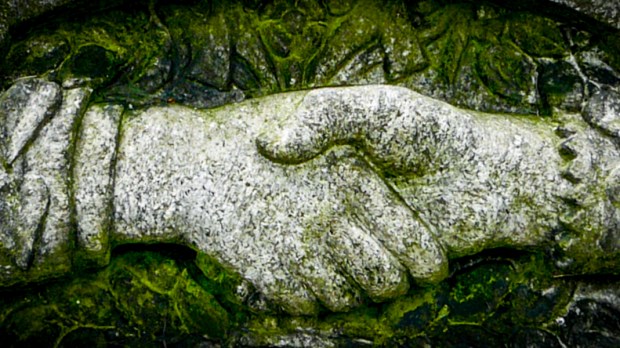Before the reception of Holy Communion the priest or deacon will say to the people, “Let us one another a sign of peace.”
It is then customary in the United States to say to one another “Peace” or “Peace be with you,” and to shake the hand of those standing in close proximity. What’s interesting is that this liturgical gesture has ancient roots and has been part of the Mass since the very beginning.
The spiritual symbolism of the act is found in the Gospel of Matthew, where Jesus said, “If you are offering your gift at the altar, and there remember that your brother has something against you, leave your gift there before the altar and go; first be reconciled to your brother, and then come and offer your gift” (Matthew 5:23-24).
The current General Instruction of the Roman Missal confirms this symbolism and explains, “There follows the Rite of Peace, by which the Church entreats peace and unity for herself and for the whole human family, and the faithful express to each other their ecclesial communion and mutual charity before communicating in the Sacrament” (GIRM 82).
The early Christian community took to heart the instructions of Jesus and incorporated the action into their celebrations of the Eucharist.
The Apostolic Constitutions, a document written in the 4th century, instructs that after the Prayer of the Faithful, “let the bishop salute the church, and say, The peace of God be with you all. And let the people answer, And with your spirit; and let the deacon say to all, Salute one another with the holy kiss.”
What we call the “sign of peace” the early Church called the “kiss of peace.” It was a custom in Mediterranean culture at the time (and still is today) to greet family and friends with a kiss.
This gesture is found throughout the liturgical history of the Church and from the time of St. Gregory the Great was seen as a pre-requisite for the reception of Communion.
The kiss of peace was typically given only to those standing next to each other and it was later developed that the kiss of peace descended from the sanctuary and was passed on to the people, symbolizing that peace comes from Christ. This was even further cemented when the priest would first kiss the altar and then pass on that kiss to his attendants.
In other rites of the Church the kiss of peace took on different forms. Joseph Jungmann explains in The Mass of the Roman Rite how, “Among the East Syrians it is customary for each one to clasp the hands of his neighbor and kiss them. Among the Maronites the faithful clasp the neighbor’s fingers with their own, then kiss the latter. Even more reserved are the Copts, who merely bow to their neighbor and then touch his hand.”

Read more:
What does it mean to be “Roman” Catholic?
By the 17th century the kiss of peace was restricted in the Roman Rite to only those present in the sanctuary and was not passed on to the faithful in their pews. It was sometimes customary for the clergy to use a “pax (peace) board,” a wooden paddle that each minister would kiss and pass to the next.
Then after the Second Vatican Council the Church took a new look at the ancient custom and decided to restore the original action of the faithful, entrusting each conference of bishops with task of determining the cultural sign most appropriate.
The sign of peace is a highly symbolic act that is meant to point towards the disposition of heart required for receiving the Holy Eucharist. It reminds the faithful that in order to be in full communion with Christ, one must first “love the Lord your God with all your heart, and with all your soul, and with all your mind, and with all your strength,” and not forget to “love your neighbor as yourself” (Mark 12:30-31).

Read more:
This is why church pews were invented

